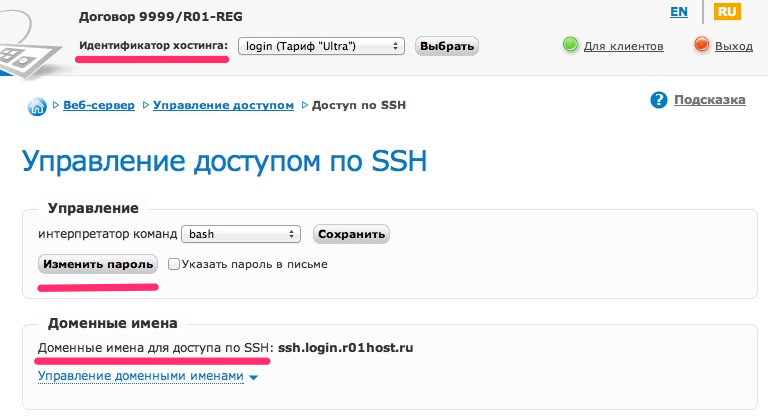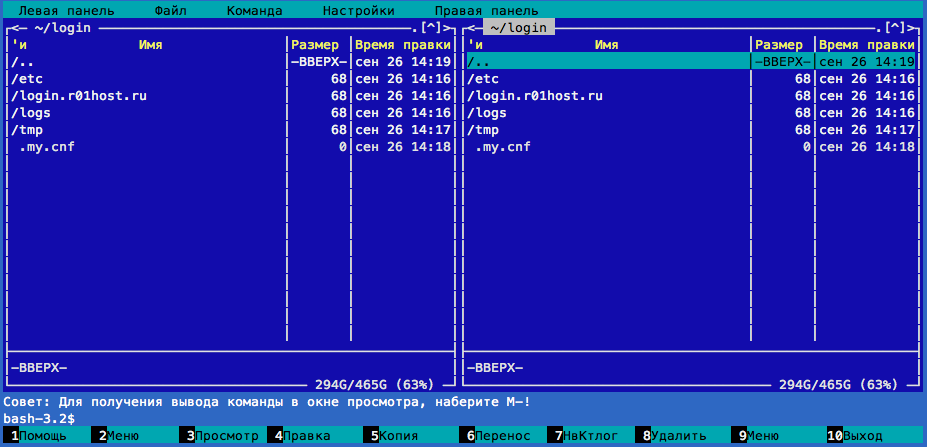| Help |
|
SSH — access and program setup
Contents
1. General information
2. Information for connection
3. Working with hosting using Midnight Commander
4. Work with hosting from command line
4.2. Moving along file system
4.3. Viewing directory contents
4.4. Creation and deletion of files and directories
4.5. Viewing and editing file contents
4.6. Copying and moving files
4.7. Changing access rights
4.8. Processes management
4.9. Work with archives
4.10. Files search
SSH (Secure SHell) — is a network protocol enabling connection with the remote server and running commands on it, uploading files and creating tunneling of TCP connections. The key feature is encryption of the transmitted data. By default, command interpreter bash is implemented on hosting.
The information for connection to server through SSH and SFTP can be viewed at "Web server" — "Access management" — "SSH" of the control panel (https://www.r01.ru, section "Account manager").

- Server address (host): ssh.identifier.r01host.ru — specified in "Domain names" block.
- "Identifier" is a unique name of the hosting service that is specified in the top part of the control panel next to the agreement number.
- Name of SSH user (login): identifier.
- To obtain password of SSH user click on "Change password". New password will be displayed on the screen. To send password to your email contact address, check "Specify password in letter".
For connection to the hosting server via SSH, install ssh-client on your computer.
- Configuration of PuTTY ssh client
To upload files on hosting use SFTP client.
- Access to virtual server through SFTP
3. Working with hosting using Midnight Commander
Midnight Commander is a two-panel file manager. It has a built-in text editor.

To run Midnight Commander connect to hosting via SSH and enter command
mc
Basic hot keys:
- F1: Help;
- F3: Built-in file viewer;
- F4: Built-in text editor;
- F5: Copy file;
- F6: Remove (rename) file;
- F8: Delete file;
- F9: Display drop-down menu;
- F10: Program exit;
- Tab: Switching between panels;
- Insert: Check file for operations with several files, for example, for copying
4. Work with hosting from command line
To get help about command of interest in command line enter:
man command
to finish work with the help click on "q".
The brief note about the command may be received by running it with setting --help or -h:
command --help
Display current directory:
pwd
Go to user home directory:
cd
Go to tmp directory located in the current directory:
cd tmp
Go to directory by full path /home/login/sitename.ru/docs (root directory of website name.ru):
cd /home/login/sitename.ru/docs
Go to parent directory (on a higher level):
cd ..
Go to previous directory:
cd -
4.3. Viewing directory contents
Display contents of the current directory (except for hidden files):
ls
Display all contents of the current directory with the detailed information:
ls -la
Display all contents of tmp directory with the detailed information:
ls -la tmp
Display size of tmp directory:
du -sh tmp
4.4. Creation and deletion of files and directories
Create new directory foo in the current directory:
mkdir foo
Create structure of directories foo/bar/baz in the current directory:
mkdir -p foo/bar/baz
Delete directory foo in the current directory. The directory shall be empty:
rmdir foo
Delete directory foo with all files and subdirectories:
rm -rf foo
Create blank file foo:
touch foo
Delete file foo:
rm foo
4.5. Viewing and editing file contents
View the contents of the text file (log-file of the website) (Click "q" to exit):
less sitename.ru/logs/access_log
Open file foo in text editor:
mcedit foo
Copy file foo into file bar:
cp foo bar
Copy the contents of directory "old" into directory "new":
mv old/* new/
Rename file foo to file bar:
mv foo bar
Move file foo to existing directory bar under baz name:
mv foo bar/baz
Recommended access rights on hosting for files 644 (rw-rw-rw-), for directories 755 (rwxr-xr-x).
Make file foo executable:
chmod 755 foo
Make file foo read-only:
chmod 444 foo
Changing access rights for all directories, contained in directory foo on 755:
find foo -type d -exec chmod 755 {} \;
Changing access rights for all directories, contained in directory foo on 644:
find foo -type f -exec chmod 644 {} \;
Show information about processes in real time (Press "q" to exit):
top
Show detailed information about all processes in progress:
ps auxww
Finish process work by its process identifier (PID) 1234:
kill 1234
Finish process work by its name:
killall httpd
Restart Apache server::
~/etc/rc.d/httpd restart
Restart Nginx server:
~/etc/rc.d/nginx restart
Create archive of docs directory:
tar -czf archive.tar.gz docs
Unpack archive.tar.gz:
tar -xzf archive.tgz
Unpack archive.zip:
unzip archive.zip
Unpack archive.rar:
unrar x archive.rar
Unpack archive.gz:
gunzip archive.gz
Among website files find those containing text "login.mysql" (server address to access database):
grep -R "login.mysql" sitename.ru/docs
Find in the current directory and subdirectories files index.php:
find . -name index.php
Support: support@r01.ru
Office: 1 Bolshoy Gnezdnikovsky Lane, building 2, Moscow (Tverskaya metro station, entrance No. 9, Voznesensky business center)